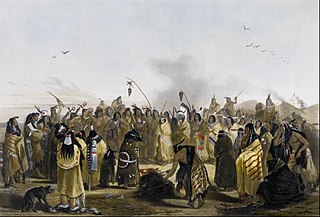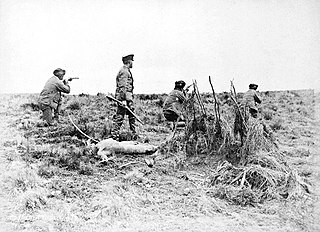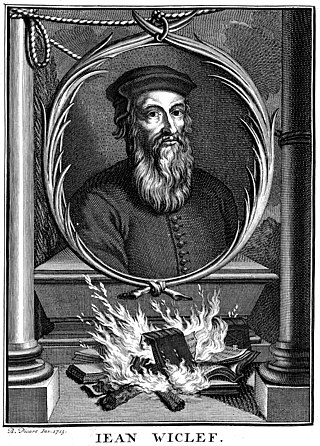Catharism was a Christian quasi-dualist or pseudo-Gnostic movement which thrived in Southern Europe, particularly in northern Italy and southern France, between the 12th and 14th centuries. Denounced as a heretical sect by the Catholic Church, its followers were attacked first by the Albigensian Crusade and later by the Medieval Inquisition, which eradicated the sect by 1350. Many thousands were slaughtered, hanged, or burnt at the stake, sometimes without regard for age or sex.

The Albigensian Crusade, also known as the Cathar Crusade (1209–1229), was a military and ideological campaign initiated by Pope Innocent III to eliminate Catharism in Languedoc, what is now southern France. The Crusade was prosecuted primarily by the French crown and promptly took on a political aspect. It resulted in the significant reduction of practicing Cathars and a realignment of the County of Toulouse with the French crown. The distinct regional culture of Languedoc was also diminished.

The Waldensians, also known as Waldenses, Vallenses, Valdesi, or Vaudois, are adherents of a church tradition that began as an ascetic movement within Western Christianity before the Reformation. Originally known as the Poor of Lyon in the late twelfth century, the movement spread to the Cottian Alps in what is today France and Italy. The founding of the Waldensians is attributed to Peter Waldo, a wealthy merchant who gave away his property around 1173, preaching apostolic poverty as the way to perfection.

"The Most Dangerous Game", also published as "The Hounds of Zaroff", is a short story by Richard Connell, first published in Collier's on January 19, 1924, with illustrations by Wilmot Emerton Heitland. The story features a big-game hunter from New York City who falls from a yacht and swims to what seems to be an abandoned and isolated island in the Caribbean, where he is hunted by a Russian aristocrat. The story is inspired by the big-game hunting safaris in Africa and South America that were particularly fashionable among wealthy Americans in the 1920s.

Scalping is the act of cutting or tearing a part of the human scalp, with hair attached, from the head, and generally occurred in warfare with the scalp being a trophy. Scalp-taking is considered part of the broader cultural practice of the taking and display of human body parts as trophies, and may have developed as an alternative to the taking of human heads, for scalps were easier to take, transport, and preserve for subsequent display. Scalping independently developed in various cultures in both the Old and New Worlds.

The Selk'nam, also known as the Onawo or Ona people, are an indigenous people in the Patagonian region of southern Argentina and Chile, including the Tierra del Fuego islands. They were one of the last native groups in South America to be encountered by migrant Europeans in the late 19th century. In the mid-19th century, there were about 4,000 Selk'nam; in 1916 Charles W. Furlong estimated there were about 800 Selk'nam living in Tierra del Fuego; with Walter Gardini stating that by 1919 there were 279, and by 1930 just over 100.

Julius Popper, known in Spanish as Julio Popper, was a Romanian-born Argentine colonial engineer, adventurer, and explorer. He was known as a modern "conquistador" of Tierra del Fuego in southern South America, and was both a controversial and influential figure. Popper was one of the main perpetrators of the genocide against the native Selk'nam people in the islands, and the circumstances surrounding his own death remain a mystery.

Wolf hunting is the practice of hunting wolves. Wolves are mainly hunted for sport, for their skins, to protect livestock and, in some rare cases, to protect humans. Wolves have been actively hunted since 8,000 to 10,000 years ago, when they first began to pose a threat to livestock of Neolithic human communities. Historically, the hunting of wolves was a huge capital- and manpower-intensive operation. The threat wolves posed to both livestock and people was considered significant enough to warrant the conscription of whole villages under threat of punishment, despite the disruption of economic activities and reduced taxes. The hunting of gray wolves, while originally actively endorsed in many countries, has become a controversial issue across the globe. Most people see it as cruel, unnecessary and based on misconceptions, while proponents argue that it is vital for the conservation of game herds and as pest control.
In paleoanthropology, the hunting hypothesis is the hypothesis that human evolution was primarily influenced by the activity of hunting for relatively large and fast animals, and that the activity of hunting distinguished human ancestors from other hominins.

Dawson Island is an island in the Strait of Magellan that forms part of the Tierra del Fuego archipelago, 100 km south of the city of Punta Arenas in Chile, and part of the Municipality of Punta Arenas. It is located southeast of Brunswick Peninsula. It is often lashed with harsh Antarctic weather. The settlements are Puerto Harris, Puerto San Antonio and Puerto Almeida.

Fuegians are the indigenous inhabitants of Tierra del Fuego, at the southern tip of South America. The name has been credited to Captain James Weddell, who supposedly created the term in 1822.

The Most Dangerous Game is a 1932 American pre-Code horror film, directed by Ernest B. Schoedsack and Irving Pichel, starring Joel McCrea, Fay Wray and Leslie Banks. The movie is an adaptation of the 1924 short story of the same name by Richard Connell; it is the first film version of the story. In the United Kingdom, the film was released as The Hounds of Zaroff. In the film, Bob Rainsford is stranded on a remote island after a yacht crash. He discovers a luxurious house owned by a big game hunter, Zaroff, who is hosting two other shipwreck survivors, siblings Eve and Martin Trowbridge. Zaroff hints that he has rediscovered the thrill of hunting after pursuing "the most dangerous game." That evening, Eve and Rainsford find a trophy room with human heads mounted on the wall and they realize that Zaroff has been hunting humans. Rainsford refuses to accompany Zaroff hunting, and Zaroff says that Rainsford must become the next prey. Zaroff gives Rainsford a hunting knife and a day to explore the island before he starts to hunt him at midnight. Rainsford devises two traps to use against Zaroff, but both fail. Finally, Zaroff brings out his dogs, shooting at Rainsford as a dog attacks him. Rainsford falls over a cliff with the dog, but later returns and wounds Zaroff and escapes with Eve.

Hunting in Russia has an old tradition in terms of indigenous people, while the original features of state and princely economy were farming and cattle-breeding. There was hunting for food as well as sport. The word "hunting" first appeared in the common Russian language at the end of the 15th century. Before that the word "catchings" existed to designate the hunting business in general. The hunting grounds were called in turn lovishcha ("ловища"). In the 15th-16th centuries, foreign ambassadors were frequently invited to hunts; they also received some of the prey afterwards.

The Selk'nam genocide was the systematic extermination of the Selk'nam people, one of the four indigenous peoples of Tierra del Fuego archipelago, in the late 19th and early 20th centuries. Historians estimate that the genocide spanned a period of between ten and twenty years, and resulted in the decline of the Selk'nam population from approximately 4,000 people during the 1880s to a few hundred by the early 1900s.

The Apache–Mexico Wars, or the Mexican Apache Wars, refer to the conflicts between Spanish or Mexican forces and the Apache peoples. The wars began in the 1600s with the arrival of Spanish colonists in present-day New Mexico. War between the Mexicans and the Apache was especially intense from 1831 into the 1850s. Thereafter, Mexican operations against the Apache coincided with the Apache Wars of the United States, such as during the Victorio Campaign. Mexico continued to operate against hostile Apache bands as late as 1915.

The Fuegian dog, or Yahgan dog, or Patagonian dog, is an extinct type of canid. Its ancestry is a matter of scientific debate, though traditionally it was thought to be bred and domesticated from the South American culpeo, also known as the culpeo fox.

Mow-way or Moway also referred to by European settlers as Shaking Hand or Hand Shaker, was the principal leader and war chief of the Kotsoteka band of the Comanche during the 1860s and 1870s, following the deaths of Kuhtsu-tiesuat in 1864 and Tasacowadi in 1872.

Proto-Protestantism, also called pre-Protestantism, refers to individuals and movements that propagated various ideas later associated with Protestantism before 1517, which historians usually regard as the starting year for the Reformation era. The relationship between medieval sects and Protestantism is an issue that has been debated by historians.

"The Most Dangerous Game" is an influential 1924 short story by Richard Connell. It tells the story of big-game hunter Sanger Rainsford becoming the hunted when trapped on a jungle island owned by General Zaroff, a Russian aristocrat who has turned to hunting man after growing bored of hunting animals.
















